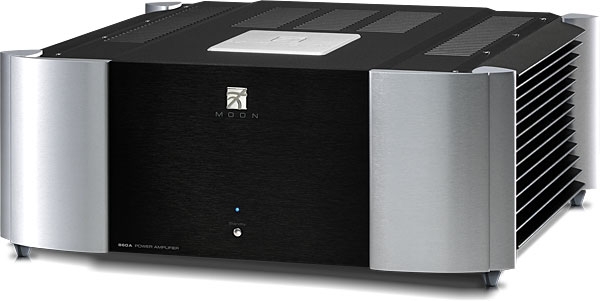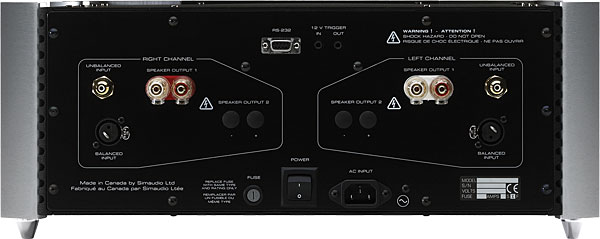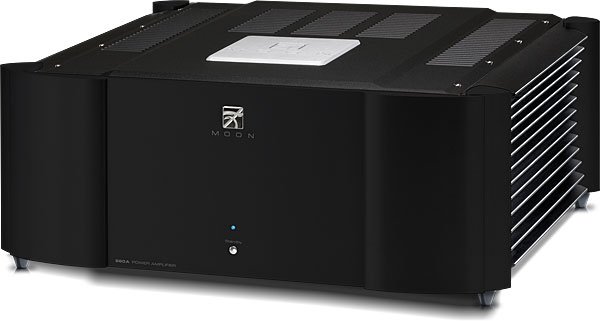| Columns Retired Columns & Blogs |
And for a fraction of the cost.

The Description and Design
The Moon Evolution 860A is a solid-state amplifier with a dual-mono design and balanced differential circuitry. It pumps 200Wpc into 8 ohms or 400Wpc into 4 ohms, running in class-A up to 5W, then in class-A/B for the rest. The output stages are powered by 12 bipolar transistors per channel, each matched to extremely high standards, resulting in a wide bandwidth, minuscule distortion, and a low noise floor (or so claims the owner's manual). Circuits are DC-coupled, reducing phase shift and deepening the bass response. Two custom-built, 500VA toroidal transformers, made of high-quality, slow-rolled Japanese steel, are tightly regulated so that, as the demand for current swells, the supply of voltage dips by no more than 3%, allowing—again, according to the owner's manual—"effortless" dynamic peaks through the most complex musical passages. The output section's high damping factor (specified as 800 for frequencies below 400Hz) "ensures an excellent 'grip' on woofer cone motions." Signal paths are shortened and impedance lowered through use of a four-layer circuit board—two layers for each audio signal, one for the ground, one for the power supply—etched with copper tracings.
Simaudio's Zero Global Feedback, a standard feature in all of its amps since 1998, is claimed to lead to "more accurate" musical tones, "elimination" of phase errors, and improved dynamic range. The 860A also uses Simaudio's proprietary Lynx Circuitry (introduced in 2005), which efficiently distributes power to each active device in the amplification circuit, resulting in greater speed and dynamics.

Finally, the 860A physically resembles other Moon Evolution products, with a sleek, ultrarigid aluminum chassis with curved edges, and thumbscrew cones protruding from its four pillar feet to minimize spurious vibrations.
The Setup
The owner's manual says that the Moon Evolution 860A needs 300 hours of break-in before it sounds as good as it's going to get, and my experience supports that claim. Simaudio also suggests leaving the amp on all the time; I found that any time I turned it off for a few days or longer, it took a few days (but no longer) to warm back up.
I did all of my listening through Revel's Ultima Studio2 loudspeakers. For line-stage preamplification, I used the Moon Evolution 740P most of the time, though I occasionally swapped it out for the preamp section of the Moon Evolution 700i integrated amp and the Pass Laboratories XP-30 line-stage preamp.
To compare the 860A with other power amps, I briefly hooked up the 740P to the Pass Labs XA60.5 monoblock amps and to the amplifier section of the 700i, reconfiguring the latter's software to bypass its preamp section and volume knob. I've had the 700i in my system, off and on, for almost five years. I borrowed the Pass electronics from Stereophile's editor, John Atkinson. And I was so smitten with the sound of the Moon Evolution 740P preamp that, soon after writing up my appraisal, I bought the review sample.
The Sound
In my review of the Simaudio 740P preamplifier, I waxed about its get-out-of-the-way transparency, and the way all the music in a recording was "breathing forth at the same time." That might have struck me as a banal observation until I heard the way it reproduced the wholeness of a piano—the percussiveness of the hammers, the dynamic contrasts in the pressure and release of the pedals, the bouquet of overtones wafting in the air, the resonant vibrations of the piano itself—all of these sounds mingling at once in the same place. Ditto for the coherence of drums, and the synchronicity of a band's interplay—all were testimony to the 740P's low-level detail and distortion-free linearity.
I heard this same seamlessness with the 860A power amp; that is, the 860A amplified these details without adding colorations of its own. But I also heard other things that hadn't quite been picked up by the other amps I'd hooked up to the 740P—and that I hadn't heard, to such a degree, with other Simaudio amps. Most noticeable was the bass: subterranean, articulate, complex—and musical, not just a mush of bass tones. From Dave Douglas's Charms of the Night Sky (CD, Winter & Winter 910 015-2) I could clearly hear not just which notes but which strings of his double bass Greg Cohen was plucking: the tautness of the high strings, the thickness of the low ones, and how loosely or tightly he was clamping them on the neck. This wasn't mere "audiophile" detail for its own sake; it was the sort of detail that enriched the rhythm and flow, and that fleshed out the presence of a human musician.

The second big improvement was in the percussive edge of instruments' sounds: the strum of a guitar, the whack of a bass drum, the sss of a sibilant. Another example from that Dave Douglas album: In the March 2011 issue, when I compared the Simaudio 700i with the Krell FBI—both high-powered, high-priced integrated amps—I noted that when Douglas's trumpet and Mark Feldman's violin played in unison, both amps allowed me to distinguish the two, each in a different way. The FBI let me hear the transient attack of Douglas's mouthpiece and Feldman's bowing; the 700i let me hear their distinct harmonic overtones and the way that brass vibrations sounded different from vibrating wood and string. I didn't hear those vibrations so clearly through the FBI, nor did I hear those transient attacks so clearly through the 700i. The 860A power amp let me hear both. The overtones were still clearer than the transients, but those transients were clearly, cleanly there.
There was a similarly revealing detail in "My Funny Valentine," from Miles Davis's Cookin' (SACD/CD, Prestige/Analogue Productions LAPJ 7094 SA). When the quintet breaks into a faster tempo, the FBI revealed Philly Joe Jones letting up on the hi-hat cymbal after tapping it with his stick, an effect that adds an extra layer of rhythm and cool that I hadn't noticed with the 700i (or with many other amps I'd sampled). I could hear this extra layer with the 860A as well. Ditto for "Nuages," the first track of Chasin' the Gypsy, saxophonist James Carter's inventive tribute to Django Reinhardt (CD, Atlantic 83304-2). In the comparison with the Krell, I wrote that the 700i didn't let me hear all the subtle rhythms and counter-rhythms tapped out by the triangles, bells, woodblocks, and other percussive bric-a-brac in Carter's ensemble. Again, the 860A did show and tell all, in full flair.

And for a fraction of the cost.

The only thing the NAD M3 would blow away (or any NAD product) is its own internals!
NAD stands for shit "Not another defect". Absolutely awful reliability. And, NAD sound quality is nothing special. Cheap hifi sounding.

http://www.stereophile.com/integratedamps/107nad/

You do realize the review in the link is 8 years old?

I don't give a f*ck if Fremer went nuts for the NAD M3. Fremer also claimed the Graham Slee Era V phono stage was miraculous… Good phono stage for its price point, but a little dull. Not the greatest thing ever as Fremer proclaimed.
I have found that NAD gear gets great reviews that do not match with my appraisals when I hear them. I wonder why that is.
The Nad C375BEE was reviewed by Stereophile, and Sam Tellig just about raised a shrine in its honour. I owned it, my brother also owned one. It can be beat easily by British integrateds in the same price bracket. Really easily.
Also, mine lasted 6 months before the front board blew out. My brother was lucky: his lasted 9 months. Good luck with NAD repairs under warranty. They outsource those repairs to local repairmen. Anyone with a multimeter and a screwdriver in your area will be the NAD repairman!
Keep pushing NAD, and I will tell stories of products with 100% failure rates and so on. I know a few former NAD dealers. There is a reason they don't sell NAD anymore...

Although I'm late in chiming in dcolak... I've owned NAD amps way back when I was just a budding audiophile that could only afford entry level gear. Today, NAD is way far back in the rearview mirror. I now own more reference-standard amps such as McIntosh, Classe and Simaudio. Simply no comparison.

I have not heard this particular amp but back when i was living in Montreal a friend owned a W5 amp from Moon and I was really impressed with it, over the years have heard their gear at different shows and actually own some of their products (dac and phono preamp) and absolutely love them. I lament the price increases with each new model but c'est la vie. I have over the years owned different NAD products, not the M3 but have heard the M3 at retail outlets. Great amp but I would have to believe that long term satisfaction would be had with the Moon.

To suppose that the injection of a 1 kHz signal into a power amplifier tells you something very important is ludicrous. I recently compared a new Parasound amplifier to my own 15 year old Moon W-5. I preferred the W-5 for many reasons, one of which was its apparent greater bass output and control. The W-5 was rated at 190 Watts, the Parasound at 250 Watts. But the Moon W-5 has almost twice the transformer capacity and more than twice the power capacitance compared to the Parasound. That matters more than these spurious output measurements.

I'm surprised Simaudio chose not to add a manufacturer's comment to address the measured twenty watt/channel shortfall.
Exaggerated claims of power output in the 1970s are why the FTC clamped down and established procedures for amp ratings, but there's no way of getting around the fact that at least the 860 tested did not provide the power advertised, and it would be good to know whether the sample was defective or if the defect lies in the printed specs.

Fifteen years ago, while walking along the streets of Barcelona, I chanced upon a second hand shop called Cash Converters. As noted, CC gave a fixed amount of cash for goods in reasonable condition, from almond crackers to zebra-striped ashtrays. Therein, I saw a tiny Nad Integrated Amp designated 310. Offering a mere 20 watts aside into 8 ohms, the 310 features a dual channel single-ended driver stage powering a complimentary set of output transistors - one N channel MOSFET and the other a "state-of-the-art" PNP biopolar transistor, a toroidal transformer, and tone controls whose effect are progressively diminished as the volume is advanced. As noted by another reviewer, the simplicity of this design results in a 20% reduction of components, a feature once marketed by NAD as "Super Simple Circuity." While this little Nad quickly falters with hard rock or complex orchestral works, the simplicity of its design delivers, with limpid musical grace, the profound pleasures to be found in well-recorded jazz trios and chamber music - all for the astounding price of sixty euros. Except for brief vacations, I have never shut off my NaD 310 in 15 years, and it has never done anything but recreate the musical events I enjoy with very little artifice and not so much as a hiccup of a technical problem. Over the years, capacitors have been replaced, and I have decent interconnects, and my Audioquest Crystal Cables are connected to a second hand pair of Acoustic Energy Aegis bookshelf speakers, also bought at CC for 150 euros. For 210 euros (and remnant interconnects from a once lavish system before my family came into being) I can still be transported to audio nirvana. What gets one there is to be cherished ... So, in the late night hours, I am very thankful for having this tiny Nad in our apartment ... Listening to good music depends not so much on dollars spent as time enjoyed ... This Nad is far from bad ...